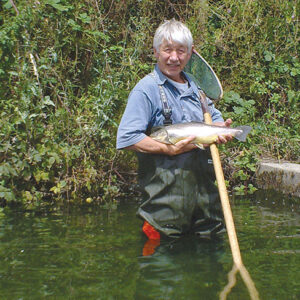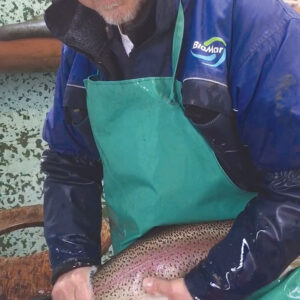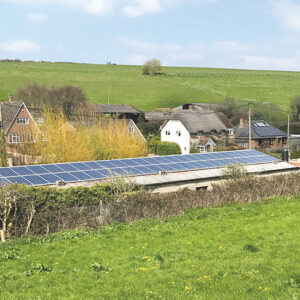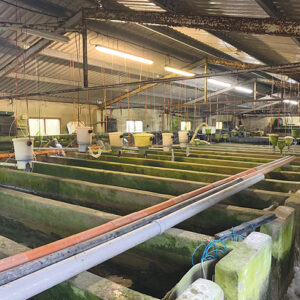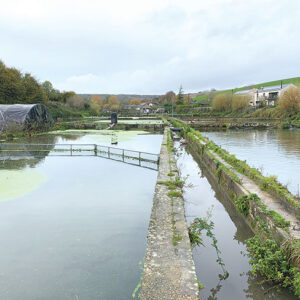
Features
Breeding
Genetics
Genetics Week
Profiles
The Winterborne legacy
English trout breeder secured 50+% growth rate gain at Houghton Springs Farm
November 23, 2023 By Colin Ley
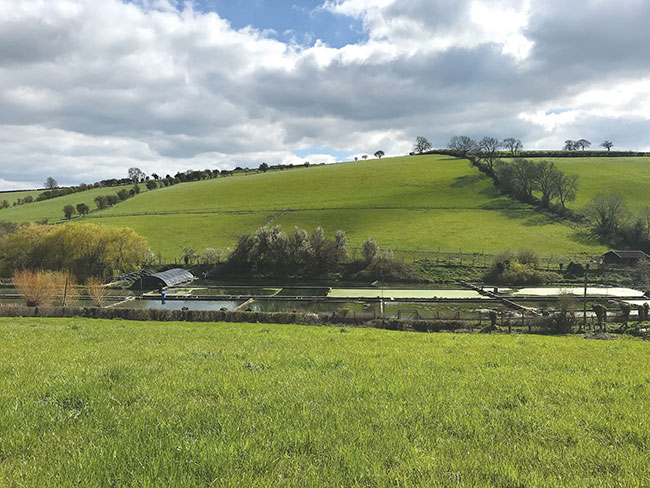 (Photo: Houghton Springs Fish Farm)
(Photo: Houghton Springs Fish Farm) A genetic selection process, launched in 2004 at Houghton Springs Fish Farm in North Dorset, England, has delivered a 51.9 per cent gain in growth performance for the unit’s “forensically selected” rainbow trout strain, known as The Winterborne.
The “forensically selected” description is the way Houghton Springs founder, Hans Hoff, described his 19-year rainbow breeding journey, speaking to Hatchery International earlier this year, prior to his passing in September after a short illness. It’s a journey which stands as an amazing legacy to Hans and his breeding vision in creating the first and only genetically selected rainbow trout strain in the U.K. and is fully demanding of the following report.
Houghton Springs is located on downland in the southern England county of North Dorset, drawing on the local groundwater resources that supply the River Winterborne at Winterborne Houghton. Bought by Hoff in 1986, the farm remains in family ownership, at least for the time being. A plan was announced late last year for Hoff to “hang up his wanders” (his phrase again) with the farm being prepared for sale in due course.
Originally established as a mixed farm to supply both rainbow and brown trout to restocking clients, the vision of delivering improved stock to a growing customer base took over as the business developed.
As a result, Houghton Spring’s breed enhancement programme, based on DNA parentage assignment, was launched with the farm’s first genetic selection process beginning in 2004. This was a couple of years before the French business, the Aqualande Group, started using DNA parentage assignment within their own breeding system.
Impressed by Aqualande’s operation, Hans visited their French hatchery in 2011 to ‘exchange ideas’ and possibly obtain some ‘old fashion’ sperm from their enhanced mix-sex strain for organic production.
While he didn’t reveal the precise details of what he learned during his time in France, Hoff returned with a deep conviction that the French industry’s ‘great emphasis’ on genetic selection and their use of data fully confirmed the benefits of investing in selective breeding.
“For comparison, I have calculated that The Winterborne strain achieved an average gain in growth of 51.9 per cent between 2004 to 2020,” he said, adding that the Aqualande Group subsidiary, Les Sources de l’Avance, has reported a 20 per cent gain in FCR and a 60 per cent gain in growth, both linked to a long-term investment in selectively bred rainbow trout.
Alongside its impressive growth record, The Winterborne has certainly stood the test of time, now being into its ninth generation.
Selection challenges
Examining the background of Houghton Springs’ breeding systems, the crucial task of initial broodstock selection at the Dorset farm began with fish being chosen for further development according to how they already performing and their broadly identical appearance. Working with fish which looked and performed identically, obviously raised the possibility that selections were derived from the same family groups, a factor which meant the potential for inbreeding between sibling crosses had to be addressed.
To counter this risk, suspect crosses were eliminated by the application of genetic finger printing techniques, whereby each individual was identified, and its family history mapped.
The tradition of selecting the ‘heaviest’ available fish for breeding, also raised the potential for bias to be created towards families which were best able to lay down fat, a trait which wasn’t particularly desirable. Hans and his team eliminated such bias risks, however, by basing their selections on ‘aggressive’ feeders, concentrating on fish which were found to be able to convert feed without laying down fat.
In addition, during the physical selection process, individual brood fish with suitably high potential were tested in a flume in which water velocity was controlled. From this base, only the top performing 50 per cent of tested fish were taken forward for further development. This largely eliminated cardiac defects and deformities in each new generation.
Identifying the fastest ‘converting’ families was completed using genetic finger printing techniques, as applied to the top performing fish, which were then grown to market size on a commercial farm.
While, to date, the Houghton Springs team have concentrated on enhancing fish growth, the fact that other traits have now been proven to be genetically linked, such as shape, ability to pigment. etc., is bringing new breeding goals into vision. It’s already recognised, in fact, that the farm’s next big breeding advance will become possible once the trout genome has been completed, alongside the established identification of makers for susceptibility to various diseases.
For the time being, however, the enhanced growth potential of The Winterborne rainbow strain is being maintained through ongoing genetic selection. This is being carried on in tandem with Arctic charr production, a significant aspect of the farm which has developed from an original importation of ova from Canada in 2006, a stock arrival which established Houghton Springs as the only producer of Arctic Charr in England.
RAS at Houghton Springs
Hatchery and early rearing processes are carried out on borehole water, with the contrast pursuit of ever faster growth rates, alongside sustainable water usage, being centred on the farm’s RAS unit. This employs two fluid bed bioreactors, following on from the removal of suspended solids through a conveyor belt filter. In addition, a specially designed computerised oxygen injection unit maintains optimum oxygen levels.
All fish movements are pumped, enabling handling to be kept to a minimum with the help of mechanical grading and electronic counting. The handling of eyed eggs, meanwhile, is facilitated through a digital Maskon Fish Egg Sorting unit.
On-farm power requirements benefit from an array of 10 kW solar panels which covers the south facing roof of the hatchery building.
For the last five years no antibiotic or other treatments, except for routine formalin flush of RAS unit, have been applied.
Water supplies to the farm come from a series of 18 artesian on-site boreholes, sunk to a depth of 25-30 metres. As a result, water quality is deemed to be high, with the benefit of flowing at a constant temperature. The risk of pollution, with this structure, is minimal.
The farm’s pumped abstraction licence is subject to a maximum of 211.2 million gallons a year, not including artesian flow or spring water.
There is a series of 28 adjoining concrete ponds with a natural chalk base varying in depth from 0.9-1.3 metres. The pond area covers 2.2 acres. A series of pumps/oxygenation units interlink the ponds to deliver effective recirculation across the entire farm. Liquid oxygen tanks and distribution systems service the entire farm.
Farm output today includes eyed trout eggs; rainbow fry and fingerlings for on-growing, sold into the table and sporting sector; and approximately 12 tonnes of Arctic Charr a year, supplied to the high end restaurant market.
Print this page
Advertisement
- SINTEF research to explore sustainability potential of sludge from salmon hatcheries
- Top 10 Under 40: Lucas Fredrickson
